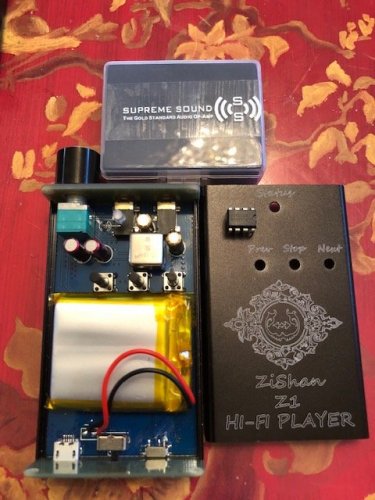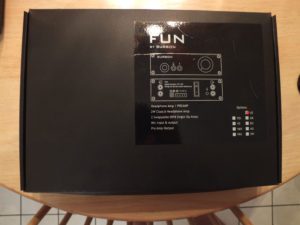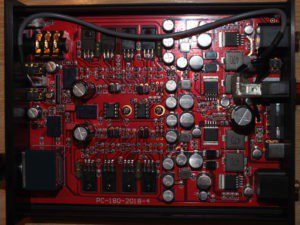When Burson announced the Fun amp, part of me was surprised, part of me was not. Burson have already got themselves a very good entry-level DAC/amp in the form of the Play, released just a few months before the Fun.
But I do believe that, if you look closely on Burson, they’ve always been more about amp than DAC. They built their name on amps, and in some cases I believe Burson will release an amp first, then a DAC-integrated version of it.
For the Play, that circle got somewhat reversed. They release the Play, got rave reviews, then remove the DAC section and improve the amp. The result: Burson Fun, at the same starting price of $300.
Does that justify the purchase, especially when the Play starts at the same price? Let’s find out.
Not Quite Elegant-Looking
Having spent months with the Burson Play, I really don’t have a lot to say about the Fun's design. All 3 of the Burson “PC” product line shares the same chassis, which is the same size as the DVDRW drives of old. As it doesn’t have the volume indicator lights that the Play does, the Fun looks a bit more boring to be honest. It’s more of a black ordinary box than the Play.
With that said, there is nothing to complain about the Play build quality. Everything feels sturdy and well assembled. The matte finish "feels" great, though I guess it'll just stay on my desk for the month to come. The volume knob seems to turn slower than the Play and it does add to the premium feeling of using the amp.
Plug and Play
As with the Play, Burson does include a screwdriver so you can easily open the chassis to roll op-amp. The number of accessories got greatly reduced from the Play's (the Fun doesn't come with any DAC), but I’m sure everyone will still be happy with what Burson included with the Fun: a 6.5-3.5 adapter and a pair of RCA cables. Both seem to be well made, totally in line with what I perceive to be Burson’s design philosophy: their products won’t turn heads, they won’t look stunning, but they will not make your desk feel any less high-end.
Using the Fun is pretty simple. We've got a set of RCA inputs at the back, connect that and you can either listen with your headphones or output the Fun to a power amp (Burson's own "Bang", for example).
What's interesting is that there's a pair of mic input/output, but those are just pass-through (per the Fun thread). At first glance I thought the mic-in should have been on the back, but then I realized it's made this way to connect with the Play's mic out more easily. Because the Play already include amplification for mic-input, the Fun doesn't.
Into the Music
I've got some source equipment for this review: an Audioquest Dragonfly, a Schitt Fulla 2 and a AK Junior DAP. My personal preference is the Dragonfly (at line level) - Fulla was a tiny bit "darker" and less detailed (which was the same experience I had with the Modi) and the AK Junior was too smooth. They do shine better on certain headphones/songs but overall I still prefer the Dragonfly and will use it for the review.
Grado RS2e – REM, Losing My Religion
For such a “soft” Alt Rock track,
Losing My Religion remains one of the most intense listening experiences that I’ve ever had. The frustration of falling in love or having a crush on someone... My heart races each times Michael went “that’s me in the corner”.
It’s not always easy to convey these feelings on a Grado. The Dragonfly for example will ruins certain moments because of its harshness. Turn it into a DAC to feed the Fun and you’ve got a perfect rendition of
Losing My Religion. Drum beats feel full and pleasant, string instruments open up the atmosphere, guitars notes tear up your heart.
Vocals lines feel extremely to the point on this one for me. Grados are famous for coloring the midrange, but this here is not quite the case. On the Fun + RS2e it feels as if Michael is sitting in front of me, telling me about his frustration of love, letting out a lonely sigh then and there. No sibilant, no smoothed edge, just Michael Stipe losing his religion and me losing mine.
The experience can be described as adding Burson elegance to Grado. The bites are still there for those who needs it (perhaps more so on other track), but the Burson + Grado sound result in a smoother, more eloquent "flow" of emotions on this specific song for me.
Sennheiser HD58X – Susan Boyle, Will the Circle be Unbroken
Elizabeth (voiced by Courtnee Draper) sang only 2 lines from this song in
Bioshock: Infinite and my heart was already taken. I like Courtnee Draper’s rendition the best, but this one from Susan Boyle is also a shiner. Hint: great songs can have dozens of great renditions.
First offf, the Vocals. I’ve always had the feeling that Burson use Sennheisers to tune their amp, which was the exact reason why I hold the Play in such high regards when I used it to drive the HD6xx. The Fun driving my new HD58x isn’t an entirely different story: it’s the familiar “colored natural” signature sound from the HD58/HD6 series.
Yet I did find a lot of faults with my HD58x, mainly because I was driving it from my laptop and my iPhone 6s. Thankfully, now I have the Burson Fun to root out all the problems: no more splintered highs and no more bloated bass. When the drums kick in at the middle of
Will the Circle be Unbroken, I could feel my HD58x slightly moving on my ears. The bass impact added a new aspect to this Folk-like song that I’d never knew of (from Courtnee Draper’s rendition): a feeling of heavenly epicness. The guitar in the background no longer get broken down into a million tiny pieces.
I didn’t expect it to, but Vocals presentation also changed. It seems that when properly powered, the mid-range has more air, a tad more details and thus more realism to it. Soundstage opened wide but not so much depth, which I think maybe Sennheiser's design (though they had that perfect 3d sound on the HD800). Another improvement is in pacing: the song changes pace 2 times and each time the Fun + HD58x handle it with ease.
Sennheiser HD58X – Pink Floyd, Time
I’ll stand by my opinion that the HD58x has a “colored natural” sound, that is, while it doesn’t stray too much from neutral, it definitely isn’t neutral. Its brother HD650 (and HD6xx?) used to be called “veiled”, and the HD58x does not stray that far from the HD6 heritage.
Which makes
Time interesting track to test. The alarm bells at the start of the track is the single most difficult passage for my headphones to render “properly”: it’s the same alarm that we listen every morning, but the way Alan Parsons and Pink Floyd mixes them together gives it an uncanny, weired-out feeling. The “tick tock” sound that follows is what I normally test my headphones for bass “resolution”.
The HD58x handles these 2 tests extremely well, but only with the Fun’s help. Driven un-properly from my laptop, Roger Waters’ bass would be come a quick line of “pffff” and the clock would sound as if it came from an iPhone, shouty and . The Fun, what can I say, corrected all these problems. The clock sound has just the right amount of bite and was so satisfying (can’t believe I’m saying this about a clock alarm) and the bass notes felt textured in "high resolution".
What came next was somewhat of a surprise to me. After that crazy opening,
Time on Fun + HD6xx is a more “streamlined” experience than on, say, the AKG Kxx or HD800. The HD6xx has more energetic trebles than its siblings in the HD6 lines, but once again nothing about it stands out – no huge soundstage, no bass rumbles either. Once that opening has passed,
I started to realize how close Time was to a country-rock song. That wonderful guitar solo and the background vocals would immediately drag me back into the Floydscape, but it was still refreshing to experience
Time in this totally new aspect.
Master & Dynamic MH40 – Adele, Water under the Bridge
I would wholeheartedly agree with the opinion that the MH40 is a closed-back version of the HD600, but the problem is that too often the closed-back part is too much. There are moments when the bass would overpower everything, as if the bass player is right next to you. No, as if the bass player is playing through power speakers placed right next to you while every one else is situated properly in the room, playing their instrument through nothing.
At 32 ohm, the MH40 wouldn’t require a powerful amp like the Play – an iPhone should do more than enough. But the real benefit here comes in the form of lean bass, provided by the Fun + V6 Classic. My laptop and iPhone, just like every laptop and phone out there, will bloat the bass a bit, which is definitely the last thing I’d want on my MH40. Fed from a clean and neutral DAC, the MH40’s low ranges will get a bit cleaner and less intrusive. The bass player thankfully is no longer playing through an amped speaker next to me.
Anyway, this makes Adele on MH40 a more tolerable experiences. In a track that is uncharacteristic upbeat like
Water under the Bridge, I’m glad that I can hear her “angelic raspy” voice in all of its beauty without having everything buried under the bass. Without all those sudden “boom”, soundstage also opens up nicely, vocals feel fuller – overall, the HD600 part has more room to shine. More refined. More elegant.
That being said, physics rules still apply, and the Fun cannot do magic for the MH40. The bass player is still sitting on my lap and the bass is still very prominent. I should look into changing the pads or something.
Symphonio Xcited 2 - Collapse under the Empire, Lost
Also marketed under the name "Notes Audio AT10", the Symphonio Xcited 2 was a big surprise with its full-bodied mids on top of the (somewhat) mild trebles and punchy bass. It doesn't have a lot of details in comparison with my bigger headphones, but what it does have is real good dynamics and an overall engaging "feel" to it. More upbeat, well-produced Post-Rock tracks such as those from Collapse under the Empire and God Is an Astronaut are such perfect match for the Xcited 2.
Becaues it's an IEM with very low impedance we're talking of, I don't think the Xcited 2 hugely benefits from the Fun. That which actually improve the Xcited 2 here is the DAC, and the Fun passes through my Dragonfly's clean, neutral sound to the Xcited 2 with a perfectly dark background, no hissing noise whatsoever. Most of the time the Fun also takes away some jagged edge from the Dragonfly (as driven from its amp), which I perceive to be a synergy problem that the Fun never had.
Grado RS2e – Lake of Tears, So Fell Autumn Rain
Grados are regarded as the go-to choices for Metal by my fellow Vietnamese Metalheads. The reason I think is because the Brooklyn house knows how to “mix” bass and mid-ranges to create a layered, thick guitar sound.
Which is exactly what I found on this song, as presented by the Fun with V6 Vivids op-amp installed. On this one, I’ve found the stock NE opamps (that comes with the starting version) a bit muffle when it comes to riffs. On the other hand, the V6 Classic feels a tiny bit too shouty. The difference could be marginal and perhaps inaudible to many, but not to me.
Anyway, the doom-ish riffs “flow” like torrents of rain on this combo. Perhaps of the way this track is mixed, the Vocals take 1 step back to let the instruments shine, but the level of raspy-ness (and sadness) is just right. The way my RS2e renditions all those keyboard riffs and cymbal crash is also perfect – there’s enough energy to keep the song from being boring, but not as much as to ruined what “Doom Metal” should be.
It’s also worth mentioning the overall presentation. The crazy thing about Metal tracks is that, they’re often not perfectly mixed and engineered, but give them a lesser DAC/amp and everything will get messed up: background instruments disappear, riffs become thin, cymbal crashes become grainy as hell. None of that happen with the Fun + RS2e with its refined, coherent representation of
So Fell Autumn Rain (and the
Forever Autumn album as a whole).
Why have Fun, though?
I should have addressed the elephant in the room first, but I guess it can be saved until we’ve discussed the sound. I can say that, with my limited experiences at the moment, the Dragonfly + Fun combo would be almost identical to the Play – at least when driving my RS2e. The Play + HD6xx is also very close to the Dragonfly + Fun + HD58x. This is me speaking from my memories as I’m away from home and don’t have the Play to compare directly with.
So, why get the Fun while the Play starts at the same price? Basically, why get a powerful amp while you can pay the same amount and get a DAC/amp that is still powerful enough to drive the HD600 to its fullest?
The answer would lie in the DAC. I really liked the Play, but after all it starts at $300, meaning its DAC unit should cost $50 or maybe less. It was just a basic Sabre that’s way too common. On the other hand, the Play was the only sub-$300 device that was powerful enough to make me feel happy with my HD6xx. Having the Play’s amp unit fed by a better DAC like my S16 at home will be a mid-fi dream, as the Aune’s amp just plainly suck.
The Play is an integrated DAC/amp – so there’s no flexibility. But thankfully, Burson has “detached” the amp unit, add even more power and reduce the number of op-amps.
Unfortunately it will be another month before I can tell you how great the Fun + S16 combo is, but even now the Dragon + Fun combo would make more sense in my situation. I can enjoy the Dragonfly at work and at 5:00PM bring it home to the Fun – bringing the Play to work and back will be too cumbersome. The Dragonfly’s amp unit holds no candle to the Fun, so that’s acceptable sound quality at work and perfect listening at home for me.
The same would apply to some of the favorite (and more expensive) DACs, such as the iDAC2 – I don’t quite like its amp unit, but it can be used as a DAC/amp and it is better than my crappy laptop’s Realtek soundcard.
So much Fun
I love the Play, but if I only had $300 to spend and had to choose between the 2 Bursons, I’d go with the Fun. This is still the Burson sound at very attractive pricing, and it gives you room to upgrade in a field that is honestly not Burson’s strongest suit – DAC. Though without digital input, the Fun is built like a tank, has plenty of power, and it gives you the Sennheiser sound of your dream. And it almost totally erased my longing for the expensive HA160 that I had a chance to try with my friend's HD650 years ago.
And that is more than enough to justify owning this $300 amp.






































![IMG_20190815_145112[356].jpg IMG_20190815_145112[356].jpg](https://cdn.head-fi.org/a/10343554.jpg)
![IMG_20190815_145416[355].jpg IMG_20190815_145416[355].jpg](https://cdn.head-fi.org/a/10343553.jpg)









 Also, FUN's PCB has a big ground plane across sensitive components and lot of polymer caps to combat ripple and noise and this makes FUN quiet and compatible with sensitive headphones like IEM's.
Also, FUN's PCB has a big ground plane across sensitive components and lot of polymer caps to combat ripple and noise and this makes FUN quiet and compatible with sensitive headphones like IEM's.











